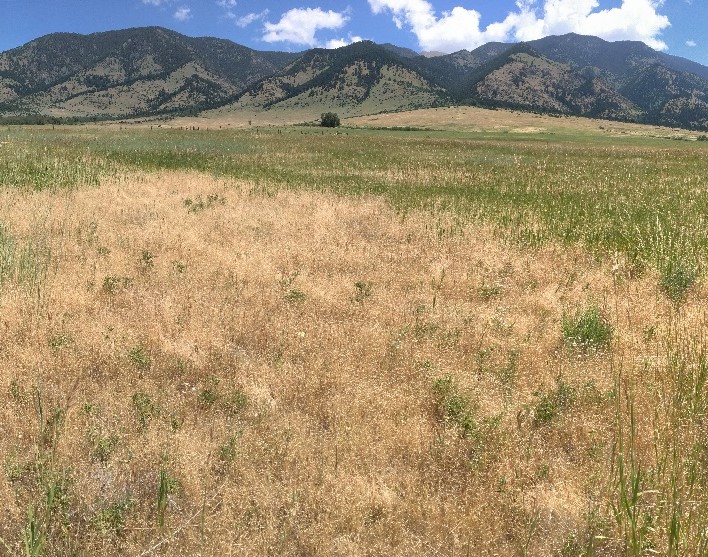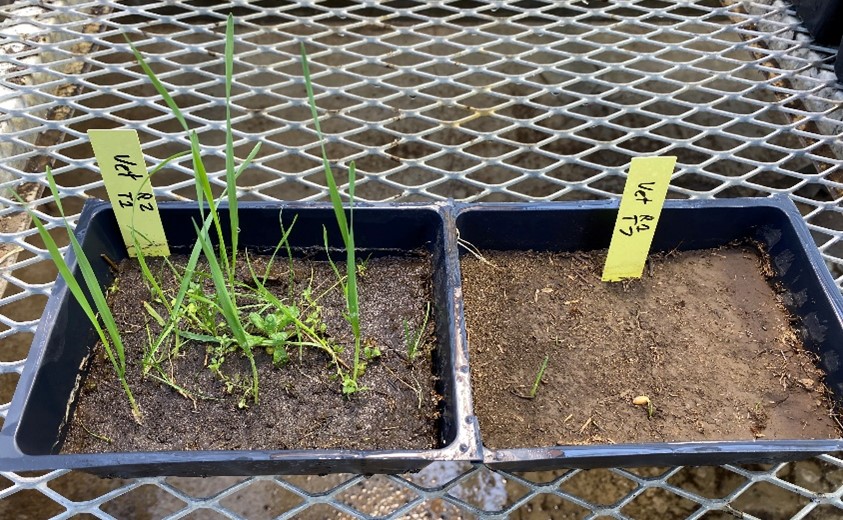Long-term Response of Ventenata and Other Vegetation to Herbicide Applications
by Jane Mangold, Professor and Extension Invasive Plant Specialist, Montana State University
Introduction

Ventenata-invaded pasture. Photo: Jane Mangold, MSU.
The invasive annual grass ventenata (Ventenata dubia) was first documented in North America in the 1950s. In the last 10 to 15 years, ventenata has rapidly spread across the inland Pacific Northwest, including portions of Montana and Wyoming. As a new invader relative to other annual grasses like cheatgrass (Bromus tectorum) and Japanese brome (B. japonicus), we were interested in how ventenata would respond to herbicides commonly used to control annual grasses. We were especially interested in indaziflam (Rejuvra®) as it was an emerging active ingredient for annual grass control.
Methods
In the fall of 2016 we applied 10 different herbicide treatments to a pasture infested with ventenata near Bozeman, MT. Aside from ventenata, the most common species in the pasture included smooth brome (B. inermis), mountain brome (B. marginatus), western wheatgrass (Pascopyrum smithii), and red sorrel (Rumex acetosella). We applied labeled rates of indaziflam, glyphosate, imazapic, propoxycarbazone-sodium, and rimsulfuron separately and indaziflam combined with each of the other four herbicides; there was also a non-sprayed control. We sampled canopy cover of ventenata and other species for 7 years (2017-2023). In the 5th year (2021), we collected seed bank samples and grew them in a greenhouse for a soil seed bank assay.
Results and Managment Implications

Seed bank samples with emerged seedlings. Non-sprayed control on left, soil treated with indaziflam on right. Photo: Jane Mangold, MSU.
Treatments that included indaziflam reduced ventenata cover to zero or close to zero for 1 to 3 years and even up to 6 years after application. Imazapic and rimsulfuron reduced cover below that of the non-sprayed control for 2 years. By the 7th year (2023), ventenata had decreased to very low cover across the entire pasture, suggesting factors other than herbicide application were playing a role in vegetative dynamics. Perennial grasses and forbs were generally not affected by any treatment. Annual forb cover and species richness (i.e., total number of species) were lowest in treatments that included indaziflam after 2 years (2018) but were similar in all treatments by 7 years. The number of seedlings emerging from the seed bank was 12 to 33 times lower in indaziflam-treated soil than soil treated with other herbicides or not treated at all. Our study suggests that a single application of indaziflam (Rejuvra®, 7 ounces per acre) along with abiotic and biotic environmental variables provided long-term (i.e., 7 years) control of ventenata and appeared to have depleted the seed bank across all species. See more results and read the entire article by Mangold, Sencenbaugh, Harvey, Rebis, and Rew.
Further Information
For more information about this month's weed post, contact Extension Invasive Plant Specialist Jane Mangold. Past posts are available in the Monthly Weed Post Directory.
This weed post is also available as a printable PDF (487 KB).
